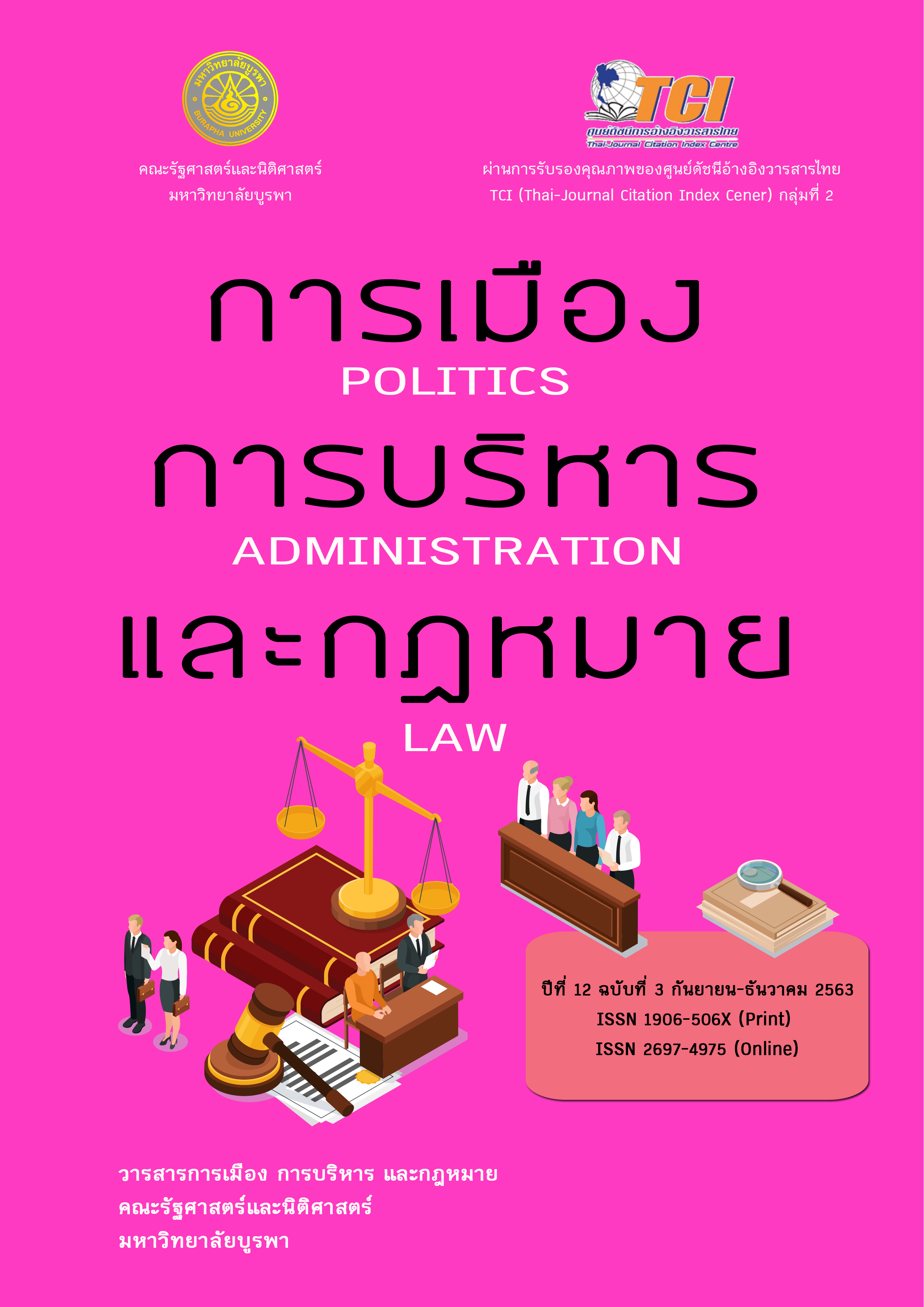แนวทางการส่งเสริมจากภาครัฐของสาธารณรัฐประชาชนจีน ในการสนับสนุนนักธุรกิจจีนลงทุนค้าขายในประเทศไทย
บทคัดย่อ
การวิจัยเรื่อง “แนวทางการส่งเสริมจากภาครัฐของสาธารณรัฐประชาชนจีนในการสนับสนุน นักธุรกิจจีนลงทุนค้าขายในประเทศไทย” มีวัตถุประสงค์เพื่อศึกษาแนวทางการส่งเสริมจากภาครัฐของสาธารณรัฐประชาชนจีนในแง่มุมต่าง ๆ ที่สนับสนุนนักธุรกิจจีนในการลงทุนค้าขายในประเทศไทย ทั้งนี้เพื่อนำรูปแบบหรือแนวทางการส่งเสริมนำเสนอแก่หน่วยงานภาครัฐของไทยโดยทำการวิจัยเชิงคุณภาพร่วมกับการวิจัยเชิงปริมาณ (Qualitative research and Quantitative research) ผู้วิจัยได้เก็บรวบรวมข้อมูลด้วยเทคนิคการวิจัยเชิงผสม (Mixed methods research) โดยดำเนินการวิจัยเชิงคุณภาพก่อน ผู้วิจัยได้ทำการสัมภาษณ์แบบเจาะลึก (In-Depth Interview) จำนวน 23 คน จากนั้นจึงทำการวิจัยเชิงปริมาณตามกรอบ PESTLE Model โดยการเก็บข้อมูลจากกลุ่มตัวอย่างนักธุรกิจจีนในเขตนิคมอุตสาหกรรมภาคตะวันออก จำนวน 400 ชุด หลังจากนั้นจึงนำข้อมูลมาวิเคราะห์โดยใช้โปรแกรม SPSS โดยเป็นการวิเคราะห์การใช้สถิติการวิจัย คือ สถิติเชิงพรรณนา (Descriptive Statistics) ซึ่งได้แก่ ความถี่ ร้อยละ ค่าเฉลี่ยและการหา ส่วนเบี่ยงเบนมาตรฐาน ทั้งนี้เพื่อเป็นการยืนยันผลจากข้อมูลเชิงลึก ทำให้ทราบแนวทางในการส่งเสริมที่ชัดเจนมากยิ่งขึ้น ผลการวิจัยเชิงคุณภาพพบว่า 1) ประเด็นด้านนโยบาย มีความชัดเจน จากการที่มีการเมืองเข้มแข็งถือเป็นส่วนหนึ่งในการผลักดันให้เกิดการดำเนินนโยบายได้อย่างต่อเนื่อง รวมถึงทุกหน่วยงานทั้งภาครัฐและเอกชนร่วมกันขับเคลื่อนนโยบายให้เห็นเป็นรูปธรรม นอกจากนี้รัฐบาลสนับสนุนให้มีโครงการ สำคัญ ๆ เพื่อรองรับนโยบาย เช่น โครงการ One Belt One Road ที่เน้นด้านโครงสร้างพื้นฐาน จากนั้นจึงใช้วิธีการจดสิทธิบัตรสินค้าเพื่อทำให้เกิดอำนาจในการต่อรอง 2) ประเด็นด้านแรงจูงใจและการอำนวย ความสะดวก รัฐบาลมีการสนับสนุนด้านเงินทุนในการดำเนินธุรกิจ รวมถึงการอำนวยความสะดวกในด้านต่าง ๆ เช่น การจัดเสวนาเพื่อจับคู่ค้าทางธุรกิจ การจัดตั้งธนาคารรวมถึงจัดทำคู่มือข้อควรรู้ประเทศต่าง ๆ 3) ประเด็นด้านการลงทุนระหว่างประเทศ รัฐบาลจีนได้เข้าร่วมองค์กรสำคัญ ๆ ทั่วโลก เช่น WTO รวมถึงความร่วมมือทางเศรษฐกิจอาเซียน 4) ประเด็นด้านบริบทของประเทศ มีการปลูกฝังคุณลักษณะเด่นที่เป็นจุดแข็งของสังคมจีนนั่นคือ การสืบทอดแนวคิดและกลยุทธ์สำคัญด้านการค้าขาย นอกจากนี้ยังมีความพยายามสร้างเครือข่าย เพื่อเป็นการรวมตัวช่วยเหลือกันเมื่อยามเกิดปัญหา 5) ประเด็นอื่น ๆ เหตุผลที่นักธุรกิจจีนลงทุนในประเทศไทย เนื่องจากมีความพร้อมหลายด้าน ทั้งด้านโครงสร้างพื้นฐาน ความเหมาะสมในพื้นที่ลงทุน รวมถึงความสัมพันธ์อันดี แต่ปัญหาที่พบหลังจากเข้ามาลงทุนคือ ด้านแรงงานไทยที่ขาด ความรับผิดชอบ กฎหมายที่เอื้อประโยชน์กับแรงงาน รวมถึงความล่าช้าของหน่วยงานภาครัฐไทย สำหรับผลการวิจัยเชิงปริมาณพบว่าค่าเฉลี่ย ส่วนเบี่ยงเบนมาตรฐานของระดับความคิดเห็นของนักธุรกิจจีนหรือตัวแทน เกี่ยวกับแนวทางการส่งเสริมนักธุรกิจจีนลงทุนค้าขายในประเทศไทย อยู่ในระดับสูงทั้งหมดทุกด้าน ( X ̅ = 3.64; SD = .629) เมื่อพิจารณาเป็นรายข้อสามารถเรียงลำดับจากมากที่สุดไปน้อยที่สุดได้ดังนี้คือ ด้านการเมืองการปกครองและนโยบายภาครัฐของสาธารณรัฐประชาชนจีนในการสนับสนุนนักธุรกิจจีนลงทุนค้าขายในประเทศไทย ( X ̅ = 3.74; SD = .683) รองลงมาคือ ด้านสภาพแวดล้อม (ด้านความปลอดภัย ความเหมาะสมในการลงทุนและความเป็นอยู่ในการดำรงชีพ) ( X ̅ = 3.70; SD = .788) ด้านเทคโนโลยี เทคนิคและนวัตกรรม ( X ̅ = 3.64; SD = .864) ด้านสังคมและวัฒนธรรม ( X ̅ = 3.63; SD = .699) ด้านเศรษฐกิจและการลงทุน ( X ̅ = 3.60; SD = .728) และด้านกฎหมายและระเบียบข้อบังคับ ( X ̅ = 3.55; SD = .785) ตามลำดับ โดยสรุปผลการวิจัยเชิงปริมาณมีความสอดคล้องกับผลการวิจัยเชิงคุณภาพคือ นักธุรกิจจีนมีความเชื่อมั่นด้านการเมืองการปกครองของรัฐบาลว่ามีความเข้มแข็ง สามารถขับเคลื่อนนโยบายที่กำหนดมาแล้วให้เกิดความต่อเนื่องได้ โดยรัฐบาลมีการวางมาตรการและจัดโครงการต่างๆ มารองรับ เพื่อให้นโยบายด้านเศรษฐกิจประสบความสำเร็จ
เอกสารอ้างอิง
กัลยา วานิชย์บัญชา. (2555). การใช้ SPSS for windows ในการวิเคราะห์ข้อมูล. กรุงเทพฯ: ศูนย์หนังสือจุฬาฯ.
วีระชัย โชคมุกดา. (2555). 150 ปี ประวัติศาสตร์จียุค “ป่วยไข้” จากสงครามฝิ่นสู่มหาอำนาจโลก (พิมพ์ครั้งที่ 2). กรุงเทพฯ: ยิปซี กรุ๊ป.
สุทัศน์ นพรัตน์. (2545). ค้าขายกับจีนไม่ยากอย่างที่คิด. กรุงเทพฯ: อินฟอร์มีเดียบุ๊คส์.
สำนักความร่วมมือการลงทุนต่างประเทศ. (2557). รายงานการลงทุนโดยตรงของของจีนในไทย. กรุงเทพฯ: สำนักความร่วมมือการลงทุนต่างประเทศ.
สมภพ มานะรังสรรค์. (2551). ธุรกิจจีนในต่างแดน. กรุงเทพฯ: มติชน.
สมภพ มานะรังสรรค์. (2551). ทุนโลกบุกจีน. กรุงเทพฯ: มติชน.
หลี่ เหริน เหลียง. (2555). โอกาสในการส่งเสริมการลงทุนของจีนในไทยอย่างยั่งยืนวิเคราะห์จากมิติวัฒนธรรม. ปริญญาดุษฎีบัณฑิต, สถาบันบัณฑิตพัฒนบริหารศาสตร์.
อักษรศรี (อติสุธาโภชน์) พานิชสาส์น. (2554ก). เศรษฐกิจจีนในมุมมองนักเศรษฐศาสตร์ไทย. กรุงเทพฯ: โอเพ่นบุ๊กส์.
อักษรศรี (อติสุธาโภชน์) พานิชสาส์น. (2554ข). เส้นทางสายไหม One Belt, One Road คัมภีร์ผู้นำจีน. กรุงเทพธุรกิจ. วันที่ค้นข้อมูล 11 มีนาคม 2562, เข้าถึงได้จาก http://www.bangkokbiznews.com/blog/detail/633823
Francis, J. A. (1967). Bright hup PM project management. NJ: prentice – Hall.
Thaibizchina. (2558). ยุทศาสตร์เดินไปของจีน. วันที่ค้นข้อมูล 15 มีนาคม 2562, เข้าถึงได้จาก http://www.thaibizchina.com/thaibizchina/th/seminar/seminar5.pdf






